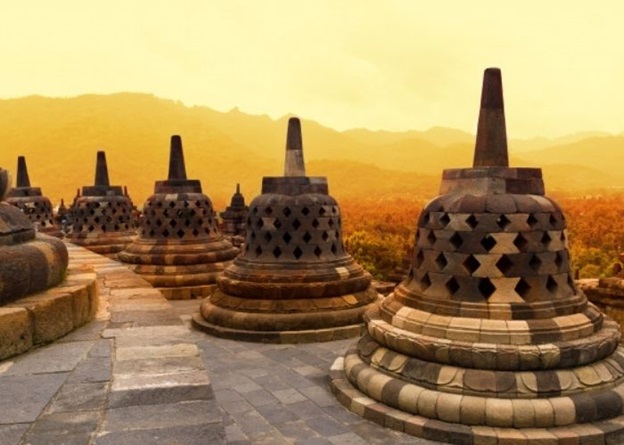Borobudur is an important place of worship for Buddhists. It is considered as one of the most beautiful temples and is one of the most famous cultural heritage sites in Indonesia. Dubbed as a symbol of harmonious Buddhist architectural aesthetics in Java, Borobudur Temple is now more popular worldwide.Therefore, it has always become a must-see list for foreigners who are visiting Indonesia. Indonesians are no exceptions, who even must be more familiar with this temple. However, there might still be people who are not aware yet of these facts of the Borobudur Temple below before they actually go on a trip. check them out!
1. Borobudur was built with volcanic piles without using any adhesive.
The Borobudur Temple is made of stones. Each stone is arranged without cement or any adhesives. These stones can only be stuck together by stacking and splicing in a certain unique pattern (Interlock). Surprisingly, it is long-lasting! Isn’t that mesmerizing? If you have once visited Borobudur and did not know for fact the whole structure was made only by stacking it, now you do.
2. No fancy tools involved and it took 23 years to build it.
Unlike today’s era, a multi-storey building can be built in a year with modern equipment, the size of the Borobudur Temple that is equal to 10-story buildings construction which only used traditional tools took more than 20 years. Back in the day, there were no bulldozers to flatten the ground, no trucks to transport the stones as well as there was no crane to lift the stones. All work is done with simple traditional tools, such as hammers and crowbars. The only fancy vehicle was the “Pedati”, it is a cart pulled by a cow. You can imagine how huge and how multiple stones should be slowly removed. Therefore, it took 23 years to build the Borobudur Temple.
3. Located in a special area
Borobudur is located in a fertile strategic area. This Buddhist temple is located between Mount Merapi and Mount Merbabu, Mount Sindoro, and Mount Sumbing. Later, Menoreh Mountains also took part in the “maintenance” of Borobudur Temple. There are two rivers around Borobudur Temple, Progo and Elo. It’s cool, right?
4. The largest Buddhist temple in the world
The Borobudur temple was included in the Guinness Book of World Records. It is the largest Buddhist temple archaeological site in the world. Borobudur is 15,129 square meters, is 42 meters high, and has ten floors. The actual length is more than 1 km and consists of 72. composition of the stupa. Furthermore, Borobudur has also been awarded the UNESCO World Heritage title.
5. It consists of 2672 reliefs
The walls of the Borobudur temple are covered with 2672 relief panels, arranged in a line, and the length can reach 6 kilometers. Known as the largest and most comprehensive Buddhist aid group in the world. In terms of artistic value, the reliefs of the Borobudur temple can be considered immense. The relief carved on the temple wall is divided into four main floors: Karmawibangga, Lalita, Wistara, Jataka, Awadana, and Gandawyuha. Each of the floors carries the life history and values of Buddha, and also records the progress and improvement of Java society at that time.
6. The statue often got stolen due to its highly-valuable price
The existence of Borobudur is not free from any risks and threats. This buddhist temple often faces threats of being destroyed that come from many external factors. Natural disasters sometimes were inevitable external factors that could destroy some reliefs in the temple, but what is more heartbreaking is that it had to face some criminal acts such as parts of temples being stolen — and which oftentimes causes destruction to the statues . In fact, some of the heads of Buddha statues in Borobudur temple have been torn down and severed due to such terrible acts. Experts suspected the thieves did commit the crime to illegally sell it to antiquities collectors at high prices.
7. Nine pagoda was destroyed by a bomb-blast in 1980
In the early post-independence period of Indonesia The Borobudur temple was also under many threats. According to the history of Borobudur, the late most terrifying threat happened in 1980. A radical leader detonated a bomb and destroyed all nine pagodas and affected the pagoda, unable to be preserved anymore. The radical leader then was arrested and imprisoned for a series of bomb threats.
8. Was declared one of the seven wonders of the world
The Borobudur temple is the largest temple left from the 9th century. This temple is no doubt very strong and is magnificent, which makes it famous all over the world. This high-value historical heritage once made it included into one of the Seven Wonders of the World. Not to mention it has such a mystery of how to build it, considering the construction did not use any adhesive and stuff.
9. Is used as precise directions
Some of you may say just look at the direction where the sun is rising to determine where the east is, yet in fact it is not that accurate. The earth rotates in a tilted state of approximately 22.1 degrees to 24.5 degrees and so it causes the sun to not always rise accurately from the east. The sun only rises from the east twice a year, estimately from March 20 to 21 and September 22 to 23. And came off as a surprise, that it seemed like the Borobudur Temple Architects were already aware of the fact and the truth of this theory. Therefore, the Borobudur temple was built from south to north, which is very accurate.
10. The pagoda is used as a sundial
If you have never been to Borobudur before, maybe you have at least ever been exposed to the picture of Borobudur. If so, you might know that there are many stupas in this temple shaped like an upside-down bell and there were around 72 pagodas in there. The largest pagoda of them all lies on the upper level of Borobudur Temple. According to the scientists, the stupa of the Borobudur Temple can be used as a sundial that determines clocks.
11. Is introduced to the world by Sir Thomas Raffles
It is obvious that the fame this phenomenal site of Indonesia has gotten was not first coming from social media like some kind of viral-culture we are all familiar with today. In ancient times, access to information from other parts of the world was very limited. However, a book entitled “The History of Java” or “The History of the Island of Java” by Sir Thomas Raffles succeeded to make the name of the Borobudur Temple spread throughout the world.
12. The meaning of the name Borobudur is remain mystery to date
Over the years, there are many speculations going around about why Borobudur Temple is named Borobudur in the first place. However, no one seems to know the true reason or meaning behind it. Many experts, though, try to define and explain the meaning of the name Borobudur, and Mr. Thomas Raffles, “The History of Java” author defines the name Borobudur in three versions. First, Borobudur which means Big Buddha (Boro = Great, Budur = Buddha), second one as in ancient places (Boro = a district name, Budur = ancient times) and lastly Borobudur as in (Boro = 众 chinese character for the word or meaning “crowd”, and Buddur = Buddha). However, yet again, the name of Borobudur still remains uncertain.
13. Borobudur’ located straight in line with Pawon and Mendut Temple
Pawon, Mendut, and Borobudur are not in the same complex area, but they are still sufficiently close to each other. Surprisingly, if you draw a straight line on the map, the location of the three temples turns out to be a well-defined straight line. These three temples are Mahayana Buddhism that spread to East Asia.

Whether or not your trips take you on a long stroll on beaches, delicious cuisines, relaxing spas and resorts, or urban attractions, additional research will still give you the best experience for your visit. Get to know more about Borobudur by visiting Wonderful Indonesia.














